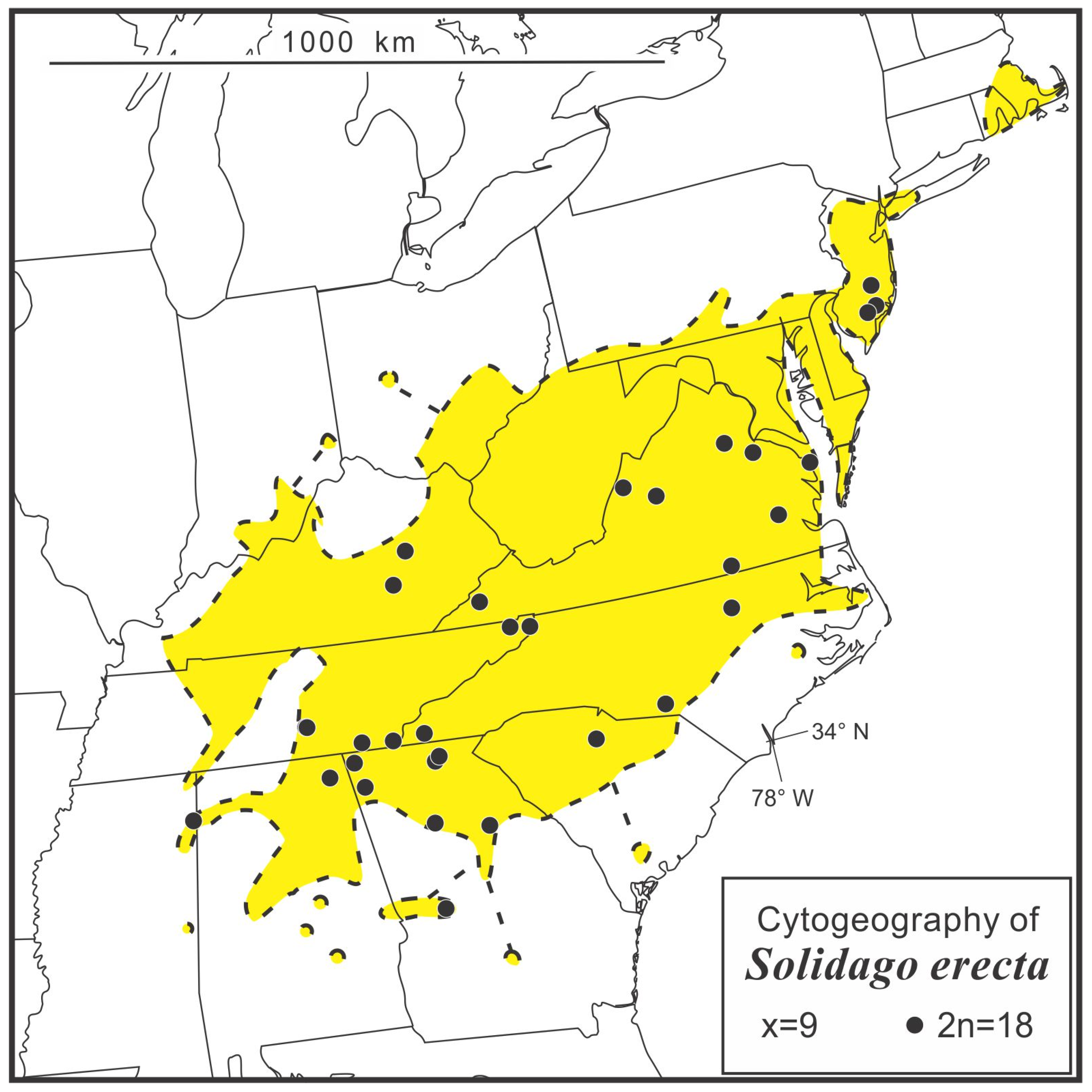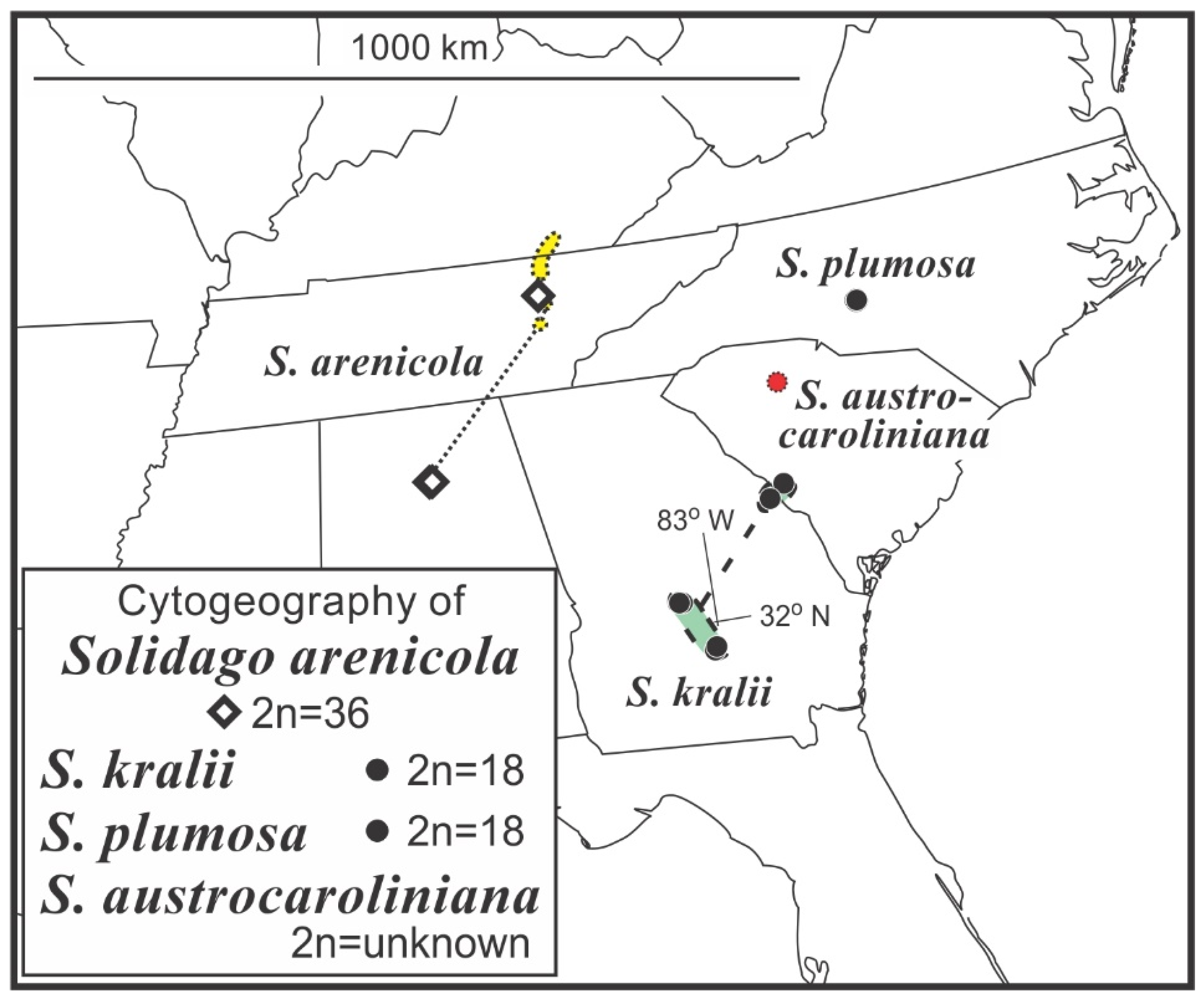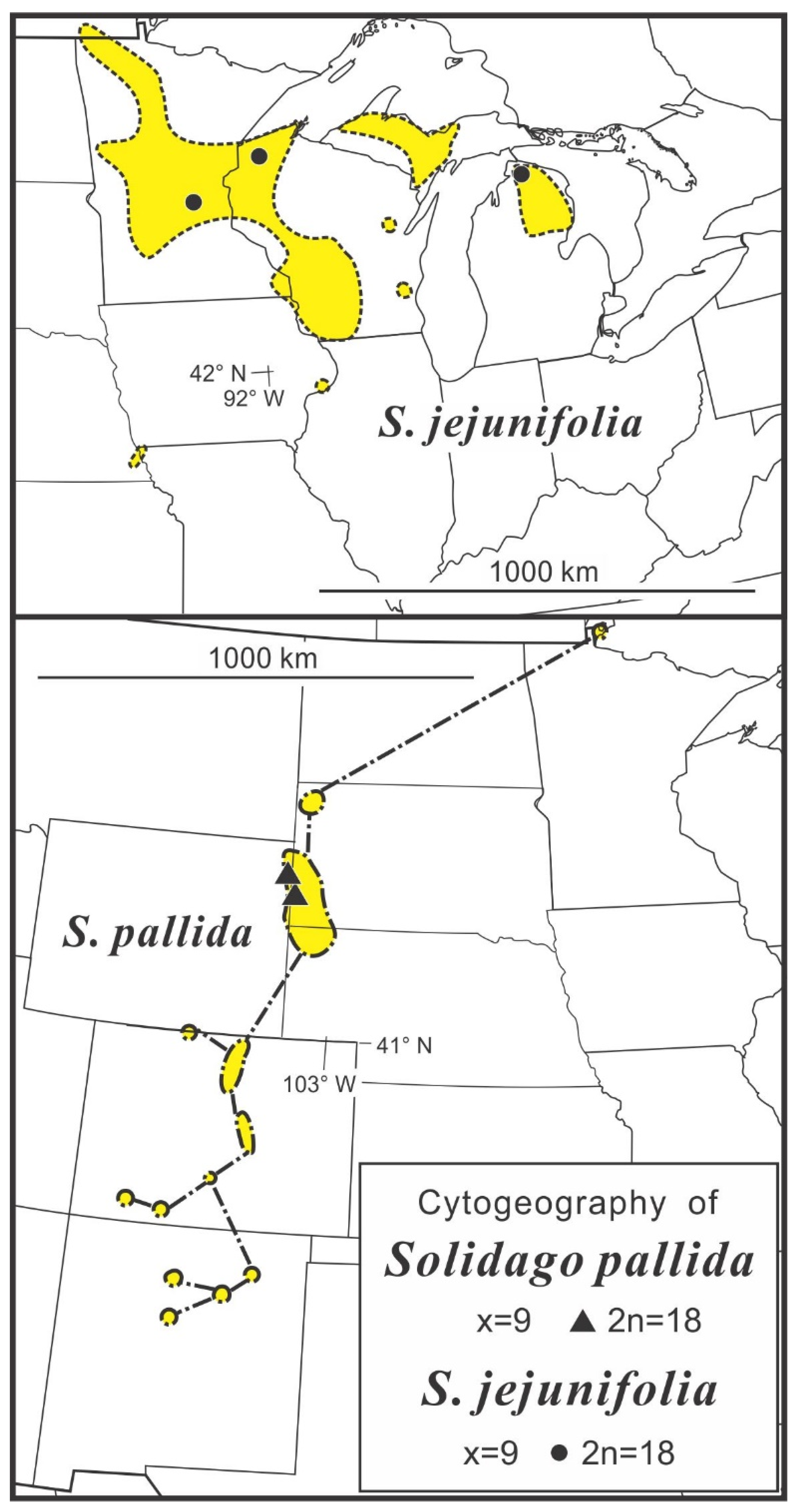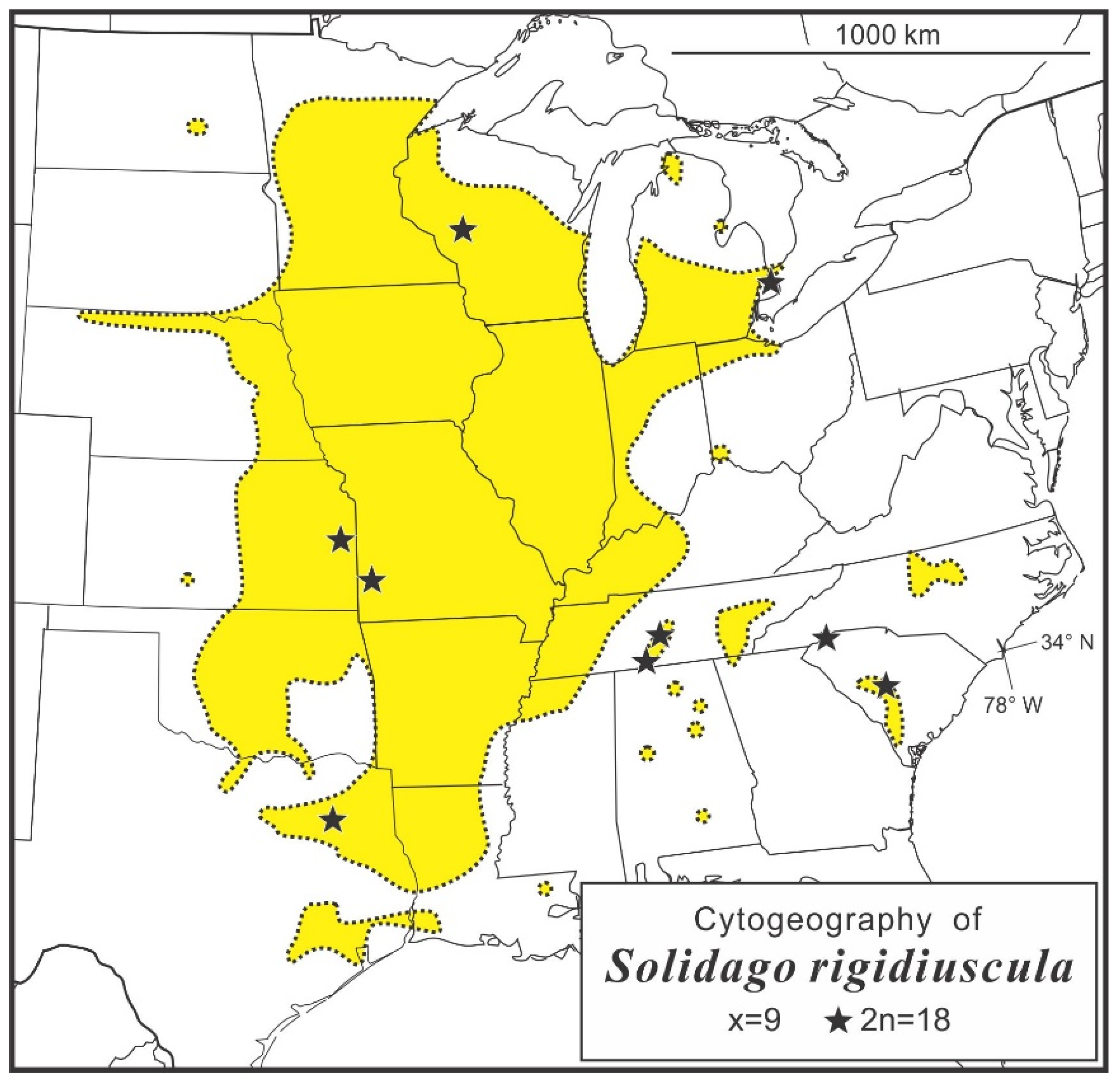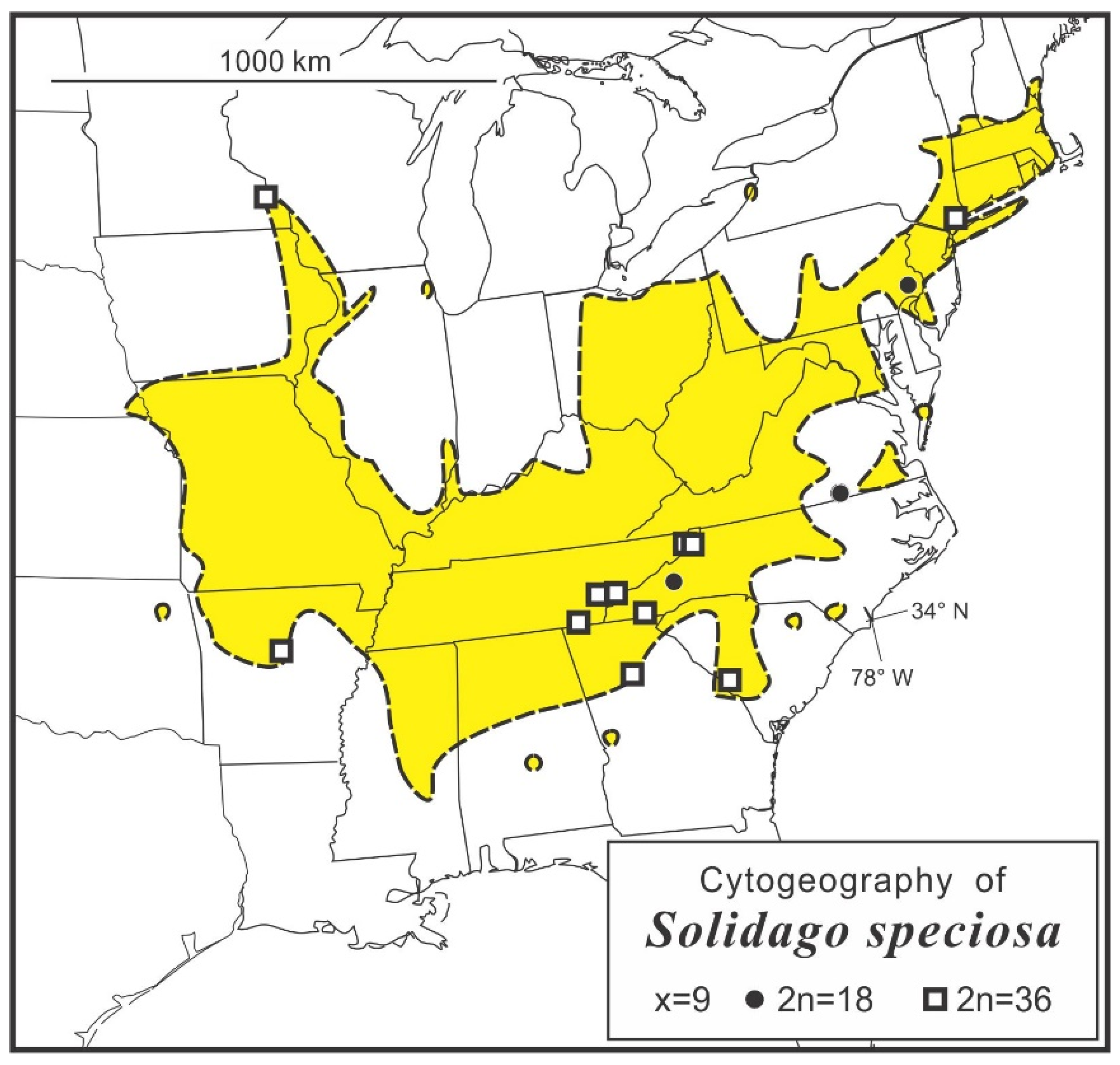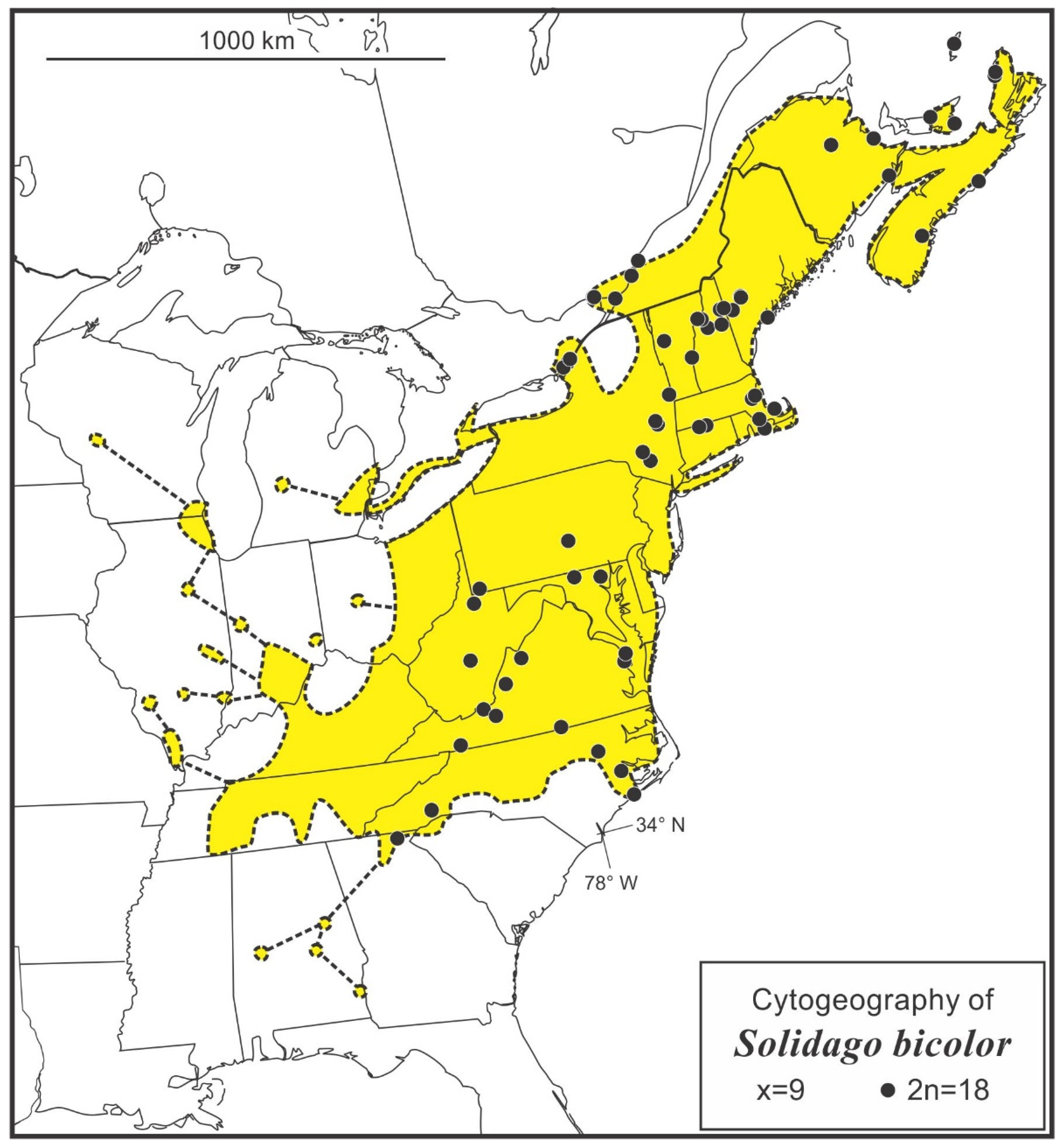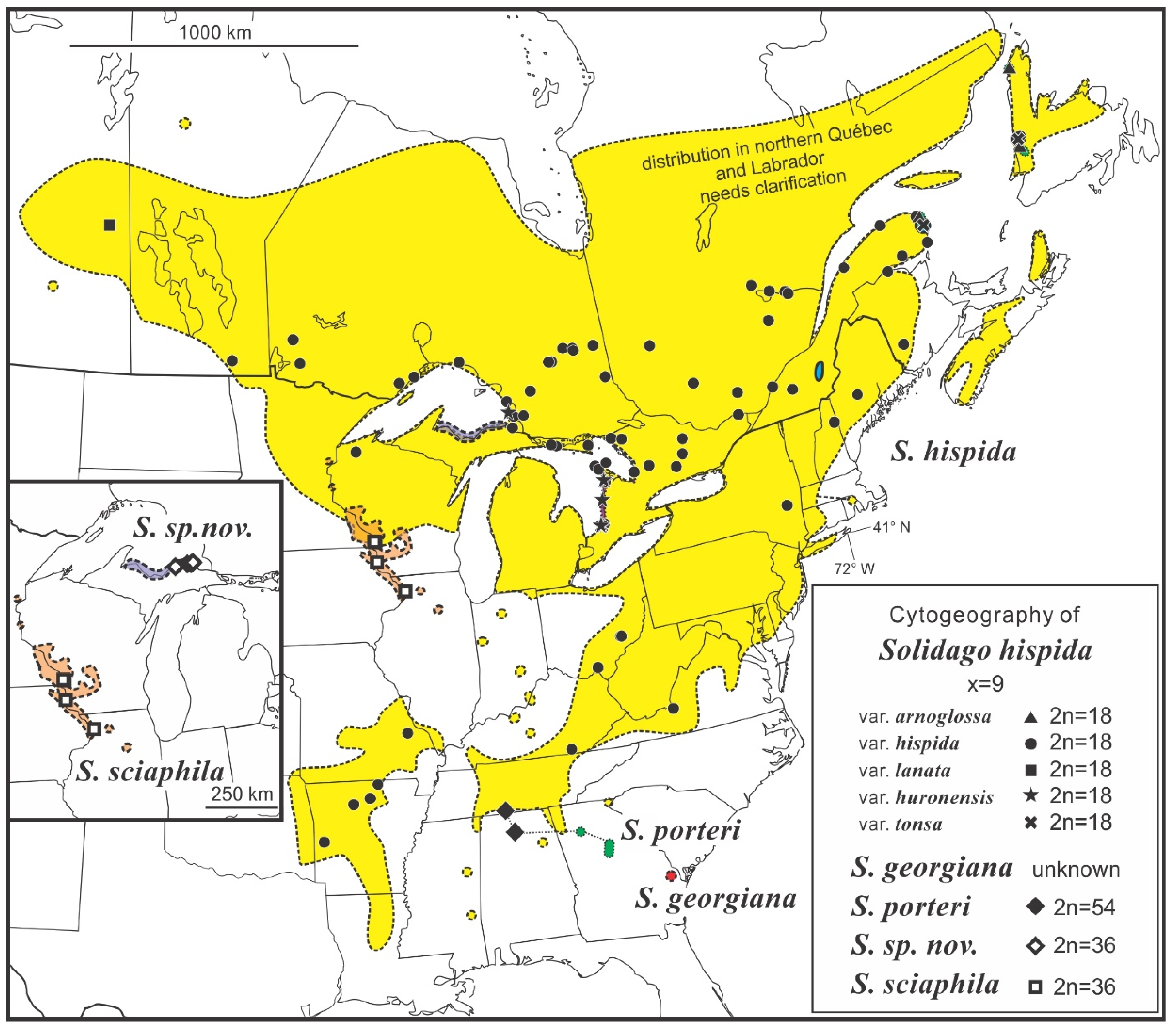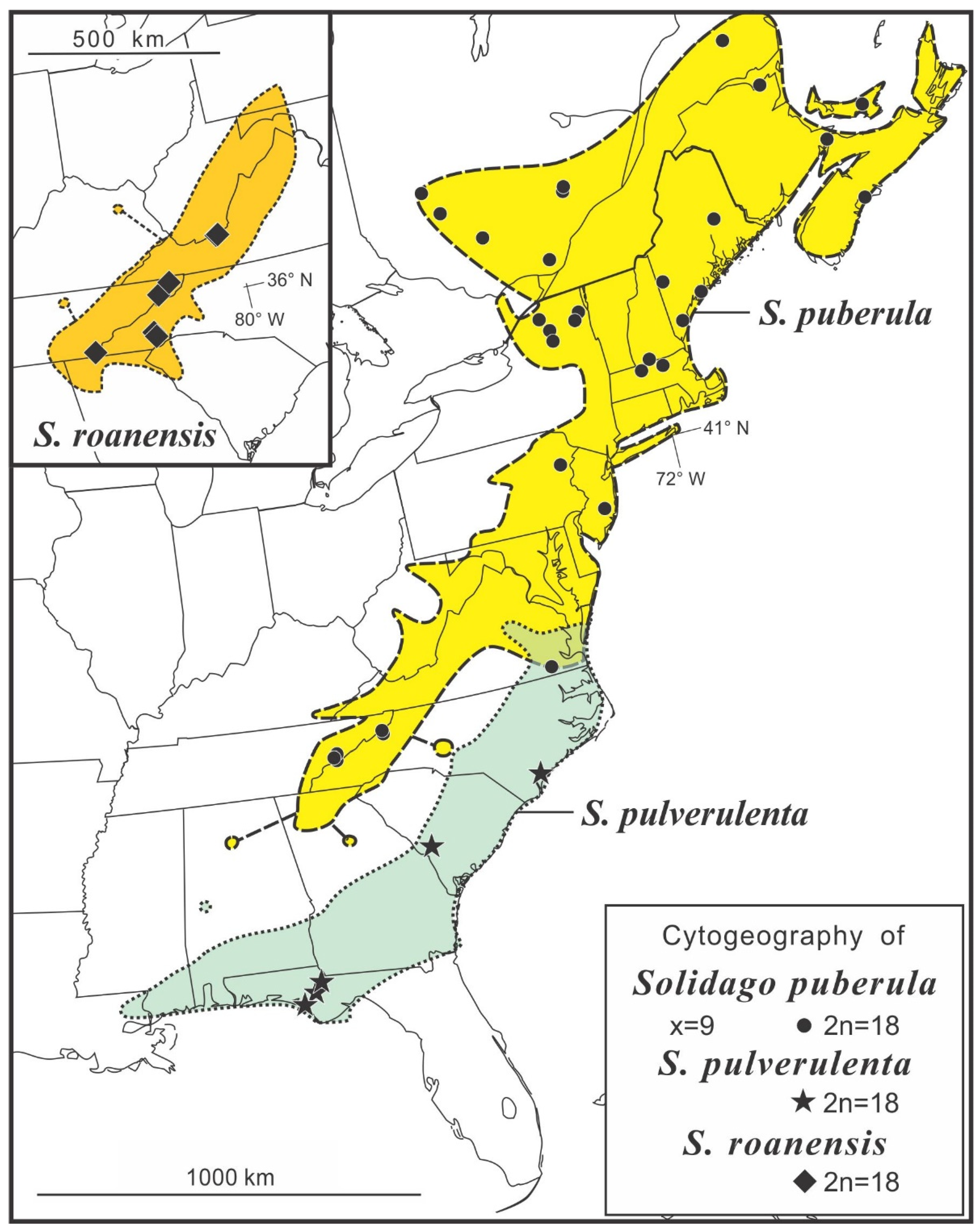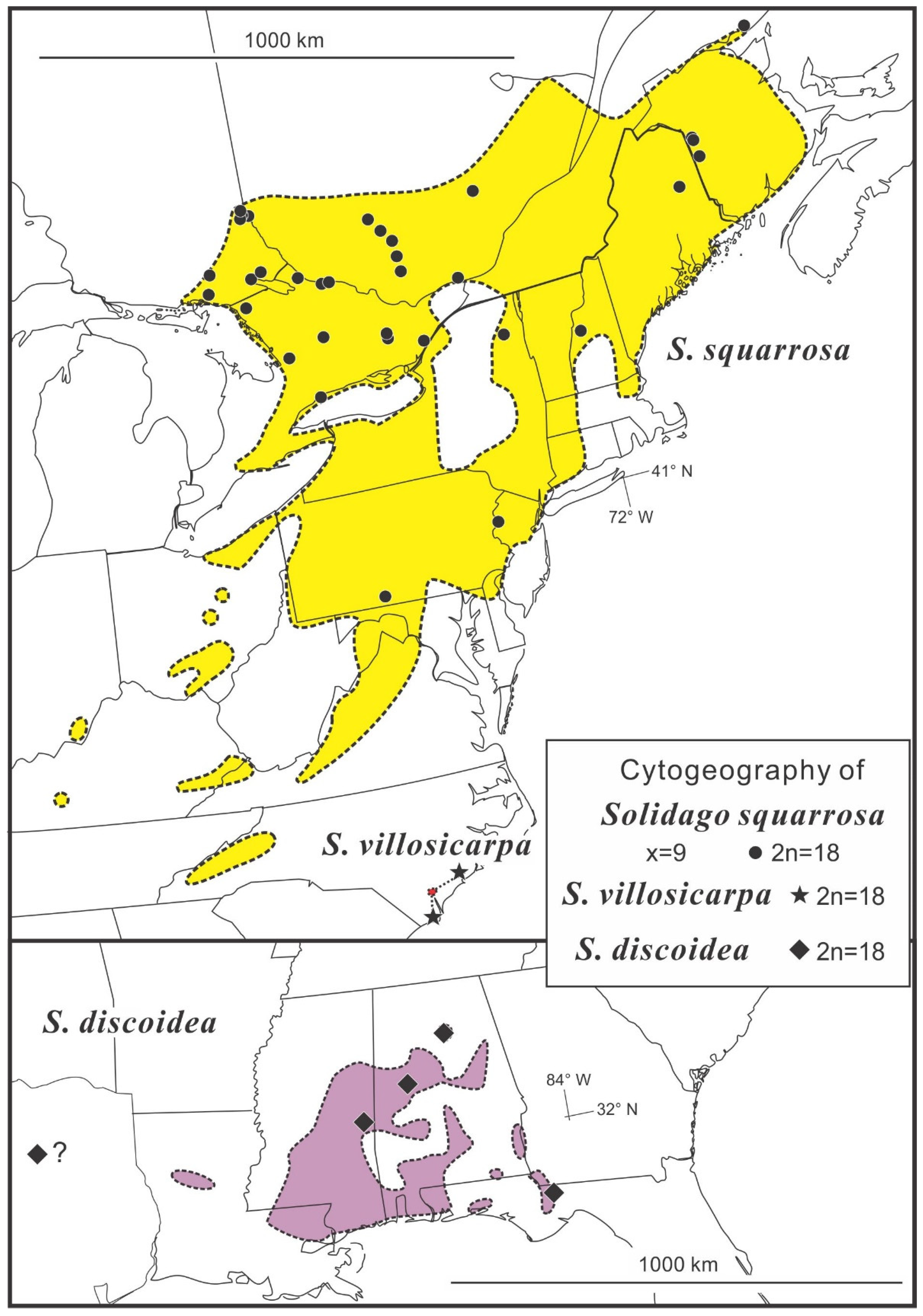Appendix A
Previously Published Chromosome Counts for Solidago sect. Erectae (Not Including Taxa of subsect. Humiles), sect. Villosicarpae, sect. Squarrosae, and sect. Brintonia; B = J.R. Beaudry; Bt = L. Brouillet; C = R.E. Cook; C, C & C = R. Cook, D. Cook and D. Cook; Ch = J. Chmielewski; S = J.C. Semple; and S & S = J.C. & B. Semple.
Solidago sect. Erectae D. Don in Loudon
Solidago subsect. Erectae (D. Don in Loudon) Semple & J.B. Beck
Solidago ser. Erectae (D. Don in Loudon) Hoffmann
Solidago arenicola B.R. Keener & Kral (all as
S. arenicola)—2
n = 36 U.S.A.
Alabama: Blount Co.,
Semple &
B. Semple 11191 (WAT [
30]), Semple & B. Semple 11196 (WAT [
30]). —4x by flow cytometry U.S.A.
Alabama: Blount Co.,
Peirson 608 (MICH [
17]),
Peirson 608 (MICH [
17]).
Tennessee: Morgan Co.,
Peirson 610 (MICH [
17]).
Solidago austrocaroliniana Semple & J.B. Nelson—No counts reported
Solidago erecta Pursh (all originally published as
S. erecta)—2
n = 9
II U.S.A.
Alabama: Jackson Co.,
G. Morton 4461 (NY [
26]),
G. Morton 4471 (NY [
26]).
New Jersey: Atlantic Co.,
S &
Suripto 9501 (WAT [
29]).
North Carolina: Franklin Co.,
S &
Suripto 9735 (WAT [
29]).
Tennessee: Hamilton Co.,
G. Morton 4446 (WAT [
26]).
Virginia: Culpepper Co.,
S &
Suripto 9735 (WAT [
29]); Rockbridge Co.,
G. Morton 6506 (NY [
26]). —2
n = 18 U.S.A.
Georgia: Dade Co.,
S 10996 (WAT [
30]); Dekalb Co.,
Morton &
Venn NA16192 (TRT [
33]); Greene Co.,
S 10868 (WAT [
30]); Taylor Co.,
S 10974 (WAT [
30]).
Kentucky: Estill Co.,
S &
Suripto 9454 (WAT [
29]); Rockcastle Co.,
S &
Suripto 9605 (WAT [
29]).
Mississippi: Itawamba Co.,
S &
Suripto 10175 (WAT [
29]).
New Jersey: Burlington Co.,
B 57-197 (MT [
23]).
North Carolina: Richmond Co.,
S, Brammall &
Hart 3046 (WAT [
25]).
South Carolina: Chester Co.,
S &
Ch 6098 (WAT [
26]).
Tennessee: Sullivan Co.,
S10771 (WAT [
30]).
Virginia: Bath Co.,
S 10721 (WAT [
30]); Essex Co.,
S &
Ch 5969 (WAT [
26]); Northumberland Co.,
S &
Ch 5984 (WAT [
26]); Wise Co.,
S &
Ch 6281 (WAT [
26]).
Solidago jejunifolia Steele—2
n = 9
II U.S.A.
Wisconsin: Douglas Co.,
S 11848 (WAT [
34]).
Solidago kralii Semple—2
n = 9
II U.S.A.
Georgia: Pulaski Co.,
S &
S 11208 (WAT [
17]); Richmond Co.,
S &
S 11217 (WAT [
40]). —2
n = 18 U.S.A.
Georgia: Ben Hill Co.,
S &
S 11216A (WAT [
17]),
S &
S 11216-B (WAT [
17]),
S &
S 11212 (WAT [
17]); Pulaski Co., C, C & C
701 (WAT [
40]).
South Carolina: Aiken Co.,
S &
S 11218 (WAT [
17]). —2
x by flow cytometry U.S.A.
South Carolina: Aiken Co.,
Peirson 605 (MICH [
17]).
Solidago pallida—2
n = 18 U.S.A.
South Dakota: Custer Co.,
S &
Bt 4476 (WAT [
26]; corrected ident. in Semple and Cook 2004 [
30], originally as
S. specios var. angustifolia).
Solidago plumosa Small—2
n = 18 U.S.A.
North Carolina: Standley Co.,
Nesom s.n. (Guy Nesom, unpub., pers. comm. BRIT Feb 20 2003.)—2
x by flow cytometry U.S.A.
North Carolina: Stanley Co.,
Peirson 610 (MICH [
17]).
Solidago rigidiuscula (Torr. & Gray) Porter—2
n = 9
II U.S.A.
Missouri: Jasper Co.,
Morton 3992 and
3993 (BRIT [
26] as
S. speciosa var.
rigidiuscula). —2
n = 18 CANADA.
Ontario: Lambton Co.,
Lamb s.n (WAT) [
26] as
S. speciosa var
rigidiuscula). U.S.A.
South Carolina: Greenville Co.,
S &
Ch 6180 (WAT [
26] as
S. speciosa var. speciosa).
Tennessee: Marshall Co.,
S &
Ch 9121 (WAT [
28] as
S. speciosa).
Wisconsin: Jackson Co.,
S &
Ch 5064 (WAT [
26] as
S. speciosa var.
rigidiuscula).
Solidago speciosa Nutt. —2
n = 18 U.S.A.
North Carolina: Buncombe Co.,
S et al.
3028 (WAT [
25] to sp.).
Pennsylvania: Montgomery Co.,
B &
Wherry 57-236 and
57-238 (MT [
23] to sp.). —2
n = 18
II U.SA.
New York: Westchester Co.,
Morton 6794 (NY [
26] as var.
speciosa). —2
n = 18
II U.S.A.
South Carolina: Edgefield Co.,
S &
Suripto 9817 (WAT [
29] as var.
speciosa).—2
n = 36 US.
Tennessee: Blount Co.,
S &
Ch 6228 (WAT [
26] to sp.). Hamilton Co.,
Morton &
Venn NA16201 (TRT [
33] to sp). —2
n = ca. 36 U.S.A.
Arkansas: Conway Co.,
Morton &
Venn NA16265 (TRT [
33] to sp).
North Carolina: Macon Co.,
Morton &
Venn NA16180 (TRT [
33] to sp).
Solidago bicolor L. (as
S. bicolor unless otherwise noted)—2
n = 9
II U.S.A.
Maine: Sagadohoc Co.,
S 10377 (WAT [
29]).
Pennsylvania: Perry Co.,
S &
Suripto 9487 (WAT [
29]). —2
n = 18.
BELGIUM. seed from Bruxelles Garden,
Morton s913 (TRT [
33]). CANADA.
New Brunswick: Northumberland Co.,
S &
Keir 4690 (WAT [
26]).
Ontario: Leeds Co.,
S 2913 (WAT [
25] as var.
bicolor); Leeds Co.,
B et al.
62-210, 62-216, 62-230, 62-232 (all MT [
24] as var.
bicolor),
S 10656 (WAT [
30]).
Québec: Argenteuil Co.
S &
Keir 4592 (WAT [
26] as
S. hispida); Deux-Montagnes Co.,
B &
Louis-Marie 55G-228 (MT [
22] as var.
bicolor); Gaspe-Nord, Ruisseau-Sorel,
B &
Louis-Marie 58-249 (MT [
23]). U.S.A.
Connecticut: Hartford Co.,
S &
Bt 3614 (WAT [
25] as var.
bicolor).
Maine: Oxford Co.,
Ringius 1620a (WAT [
26]).
Massachusetts: Bristol Co.,
B &
Seymour 57-160 (MT [
24] as var.
bicolor),
S &
Bt 3574 (WAT [
25] as var.
bicolor); Norfolk Co.,
B &
Seymour 57-161 (MT [
23] as var.
bicolor),
B &
Seymour 57-165 (MT [
23] as var.
bicolor); Plymouth Co.,
S &
Bt 3558 (WAT [
25] as var.
bicolor).
New Hampshire: Carroll Co.,
S &
Bt 3473 (WAT [
25] as var.
bicolor); Coos Co.,
Cook &
Tereszchuk C-157 (WAT [
34]),
C &
Tereszchuk C-161 (WAT [
34]); Grafton Co.,
S &
Bt 3483 (WAT [
25] as var.
bicolor),
S &
Bt 3460 (WAT [
25] as var.
bicolor).
New York: Greene Co.,
S &
Bt 3637 (WAT [
25] as var.
bicolor); Rennselear Co.,
B &
Beal 57-134 (MT [
23] as var.
bicolor); Sullivan Co.,
S 6827 (WAT [
26]).
North Carolina: Carteret Co.,
Morton &
Venn NA16560 (TRT [
33]); Craven Co.,
S &
Ch 6047 (WAT [
26]); Edgecombe Co.,
S &
Ch 6002 (WAT [
26]). Henderson Co.,
S 10827 (WAT [
30]).
Pennsylvania: Greene Co.,
S 10676 (WAT [
30]).
Vermont: Addison Co.,
S 6904 (WAT [
26]); Caledonia Co.,
S &
Bt 3487 (WAT [
25] as var.
bicolor).
Virginia: Allegheny Co.,
S 10732 (WAT [
30]); Grayson Co.,
S 10744 (WAT [
30]); Montgomery Co.,
B &
Massey 57-312 (MT [
23] as
bicolor var. ovalis),
B &
Massey 57-313 (MT [
23] as
bicolor var. ovalis).
Wisconsin: Marion Co.,
S 10681 (WAT [
30]). —2
n = 18 + 0–1 supernumerary. U.S.A.
Virginia: Giles Co.,
B &
Massey 57-328 (MT [
23] as
bicolor var.
ovalis). —2
n = 18 + 0–3 supersnumeraries. CANADA.
New Brunswick: Fundy N.P.,
Kapoor 69-xx-x ([
36] not seen [
36])—2
n = 18 + 0, 1, 3 supernumeraries. CANADA.
Québec: Co., Contrecoeur,
B et al.
59-30 (MT [
24] as var.
bicolor).
Solidago georgiana Semple—No counts reported
Solidago hispida Muhl. var. uncertain—2
n = 18 CANADA.
Québec: Boudreau s.n. (QFA; Gervais et al., 1999; to sp.);
Ringius 1653 (WAT [
26] to sp.).
Solidago hispida Muhl. var.
arnoglossa Fernald—2
n = 18 CANADA.
Newfoundland: Division No. 5,
Morton &
Venn NA12474 (TRT [
37] to sp.); near Doctors Brook,
Morton &
Venn NA12336 (TRT [
33] as
var. arnoglossa).
Québec: Bon Ami Pt.,
Morton s.n. (TRT [
37] to sp.).
Solidago hispida Muhl. var.
hispida—2
n = 9
II CANADA.
Ontario: Algoma Dist.:
S &
Brammall 2861 (WAT [
25] to sp.),
S &
Brammall 2868 (WAT [
25], to sp.),
S &
Brammall 2870 (WAT [
25] as to sp.); Bruce Co.,
S &
Brammall 2789 (WAT [
25] to sp.),
S &
Brammall 2300 (WAT [
25] to sp.); Cochrane Dist.:
S &
Brammall 2830 (WAT [
25] to sp.),
S &
Brammall 2831 (WAT [
25] to sp.); Manitoulin Dist.:
S &
Brammall 2308 (WAT [
25] to sp.); Parry Sound Dist.:
S &
Brammall 2891 (WAT [
25] to sp.); Simcoe Co.,
S 2933 (WAT [
25] to sp.); Thunder Bay Dist.:
S &
Brammall 2667 (WAT [
25] to sp.); Timiskaming Dist.,
S &
Brammall 2818 (WAT [
25] to sp.);
Québec: Laviolette Co.,
B 55-168 (MT [
22] as var.
hispida). U.S.A.
Arkansas: Polk Co.,
S &
Heard 8273 (WAT [
27] to sp.). —2
n = 18 CANADA.
Manitoba: Roseau River Valley,
Löve &
Löve 6213 (not seen or located) [
38] as
S. bicol. var.
concolor).
Newfoundland: Gros Morne Natl. Park.,
Morton &
Venn NA12163 (WAT [
37] to sp.).
Ontario: Bruce Co.,
S &
Brammall 2979 (WAT [
25] to sp.),
S10671 (WAT [
30] as var.
hispida); Cochrane Dist.: Co.,
S &
Brammall 2824 (WAT [
25] to sp.); Kenora Dist.:
S &
Bt 4142 (WAT [
26] to sp.),
S &
B. Semple. 6723 (WAT [
26] to sp.); Lambton Co.,
C &
D. Cook 74 (WAT [
30] as
var. hispida); Manitoulin Dist.,
Morton &
Venn NA10743a (TRT [
37] to sp.),
Morton &
Venn NA10749 (TRT [
37] to sp.),
S &
Brammall 2328 (WAT [
25] as to sp.); Sudbury Dist.,
S &
Brammall 2836 (WAT [
25] as to sp.),
S &
Brammall 2846 (WAT [
25] to sp.); Thunder Bay Dist.,
Morton s.n. (WAT [
37] to sp.),
S et al.
6757 (WAT [
27] to sp.).
Québec: Morton s.n. (TRT [
37] to sp.,
Dansereau et al.
58-248 (MT [
24] as
S. bicolor var.
concolor); Cap Jaseux,
B 61-278, 61- 279, 61-280 (MT [
24] as
S. bicolor var.
concolor); Drummondville,
Ringius 1653 (WAT [
26] to sp.),
Ringius 1663 (WAT [
26] to sp.); Ile Maligne,
Doucet 59-141 (MT [
24] as
S. bicolor var.
concolor); Labelle Co.,
Marcellin-Sylvio 55-190 (MT [
22] as var.
hispida); Lac St-Jean Co.,
Rolland-Germain &
Galiano 55-216 (MT [
22] as var.
hispida); Parc la Vérendrye,
B &
Doucet 59-66 (MT [
24] as
S. bicolor var.
concolor). U.S.A.
Arkansas: Fulton Co.,
S &
Heard 8315 (WAT [
27] to sp.); Searcy Co.,
S &
Heard 8298 (WAT [
27] to sp.); Stone Co.,
Morton &
Venn NA16260 (TRT [
33] as
var. hispida).
Maine: Somerset Co.,
S &
Keir 4634 (WAT [
26] to sp.).
Missouri: Madison Co.,
S et al.
3774 (WAT [
25] as
S. drummondii, corrected det. by R.D. Noyes, MO duplicate).
New York: Greene Co.,
S &
Bt 3638 (WAT [
25] to sp.);
Ohio: Hocking Co.,
S et al.
2982 (WAT [
25] to sp.); Scotia Co.,
S et al.
2987 (WAT [
25] to sp.).
Virginia: Allegheny Co.,
C &
Tereszchuk 348 (WAT [
34] as var.
hispida). —2
n = 18 + 1 supernumerary CANADA.
Ontario: Cochrane Dist.:
S &
Brammall 2825 (WAT [
25] to sp.); Sudbury Dist.:
S &
Brammall 2837 (WAT [
25] to sp.)
Solidago hispida Muhl. var.
huronensis Semple—2
n = 18 CANADA.
Ontario: Bruce Co.,
S 2452 (WAT [
25] as
as var. tonsa),
S &
Brammall 2806 (WAT [
25] as var.
tonsa),
S 10672 (WAT [
30]
as var. huronensis); Lambton Co.,
C &
C C-73 (WAT [
30] as var.
huronensis).
Solidago hispida Muhl. aff. var.
huronensis Semple—2
n = 18 CANADA.
Ontario: Algoma Dist.,
S &
Brammall 2862 (WAT; Ringius & Semple 1987, as
S. glutinosa var.
glutinosa; corrected in [
17] to
S. hispida).
Solidago hispida Muhl. aff. var. lanata (Hook.) Fernald—2n = 18 CANADA. Saskatchewan: E of Shoal Lake, Hooper 83091001 (WAT to sp.).
Solidago hispida Muhl. var.
tonsa Fernald—2
n = 18 CANADA.
Newfoundland: Table Mt.,
Morton &
Venn NA12186 (WAT [
37] to sp.).
Solidago hispida Muhl. aff. var.
tonsa Fernald—2
n = 18 CANADA.
Québec: Gaspésie Co., St. Pierre des Monts,
Morton NA4086 (TRT [
37] to sp.).
Solidago hispida × sp. 2
n = 18 CANADA.
Québec: Comté de Gaspé-Ouest,
Boudreau s.n. (QFA [
39] as
S. simplex).
Solidago porteri Small—2
n = 27
II U.S.A.
Alabama: Morgan Co.,
S &
S 11190 (WAT [
31]).
Tennessee: Giles Co.,
Estes 06795 (APSC [
31]).
Solidago sp. nov. J.A. Peirson (in press)—4
x = 36 (flow cytometry data) U.S.A.
Michigan: 4 locations (MICH [
43]).
Solidago sciaphila Steele—no previous counts reported
Solidago puberula Nutt. —2
n = 9
II CANADA.
Québec: Laviolette Co.,
B 55-162 (MT [
22] as
var. puberula). U.S.A.
Maine: Sagadohoc Co.,
S 10376 (WAT [
29], as var.
puberula); York Co.,
S &
Suripto 9586 (WAT [
29], as var.
puberula). —2
n = 18 CANADA.
Québec: Mt. Albert,
Morton s.n. (WAT [
37] to sp.); Mont Ste-Anne,
Dansereau 58-253 (MT; [
23] as var.
puberula); Rivière-aux-Rats,
B &
Doucet 59-119 (MT [
24] as var.
puberula). U.S.A.
Maine: Oxford Co.,
Ringius 1621 (WAT [
26] to sp.); Penobscot Co.,
Ringius 1629 (WAT [
25] to sp.).
Massachusetts: Franklin Co.,
S 6872 (WAT [
26] to sp.); Worcester Co.,
S 6867 (WAT [
26] to sp.).
New Hampshire: Cheshire Co.,
Seymour 57-27-1, 57-27-1-2, 57-27-1-3 (MT [
22], as var.
puberula).
New Jersey: Burlington Co.,
S &
Ch 6259 (WAT [
26] to sp.).
New York: Essex Co.,
Ringius 1534 (WAT [
26] to sp.),
Ringius 1551 (WAT [
26] to sp.); Hamilton Co.,
S &
Bt 3670 (WAT [
25] to sp.); St. Lawrence Co.,
S &
Bt 3679 (WAT [
25] to sp.),
S &
Bt 3686 (WAT [
25] to sp.).
North Carolina: Mitchell Co.,
S 10815 (WAT [
30] as ssp.
puberula).
Tennessee: Blount Co.,
S &
Ch 6227 (WAT [
26], to sp.); Carter Co.,
S 10807 (WAT [
30] as ssp.
puberula); Sevier Co.,
Beaudry et al.
57-428 (MT; [
23] as var.
puberula),
B et al.
57-441 (MT; [
23] as var.
puberula),
Morton &
J. Venn NA16169 (TRT [
33] to sp.). —2
n = 18 + 0 or 3 supernumeraries. CANADA.
New Brunswick: Sackville,
Kapoor 69-119-1 (SMUH not seen [
36] to sp.).
Québec: Rivière-aux-Rats,
B &
Doucet 59-120 (MT; [
23] as
as var. puberula),
B &
Doucet 59-220 (MT [
24] as
var. puberula).
Solidago pulverulenta Nutt. —2
n = 9
II U.S.A.
North Carolina: Bladden Co.,
S &
Suripto 9771 (WAT [
29] as
S. puberula var. pulverulenta). —2
n = 18 U.S.A.
Florida: Bay Co.,
Godfrey 63-35-2, 63-35-4, 63-35-5 (MT [
24] as var.
puberula); Calhoun Co.,
S &
Godfrey 3112 (WAT [
25] as.
S. puberula); Jackson Co.,
B &
Godfrey 57-514 (MT; [
23] as
S. puberula var.
pulverulenta).
Solidago roanensis Porter (all published as
S. roanensis)—2
n = 9
II U.S.A.
Tennessee: Carter Co.
, Morton 3853 (NY [
26]),
Morton 3854 (NY [
26]); Polk Co.,
Morton 8546 (not seen;
8545 UTCH from same location is
S. roanensis [
26]).—2
n = 18 U.S.A.
North Carolina: Haywood Co.,
C, C, &
C 557 (WAT [
34]); Transylvania Co.,
B 57-473 (MT; [
23]),
57-475 (MT; [
23]).
Virginia: Giles Co.,
B &
Massey 57-321c,
57-322,
57-323,
57-324,
57-327 (all MT; [
23]). —2
n = 18 + 0-1 supernumerary. U.S.A.
Virginia: Giles Co.,
B &
Massey 57-316 (MT; [
23]).
Solidago subsect. Humiles (Rydb.) Semple See Peirson et al., 2012 [
17] for review.
Hybrids
Solidago bicolor ×
S. puberula—2
n = 18 U.S.A.
Maine: Oxford Co., S et al. 2989 (WAT [
25] as
S. hispida).
Solidago hispida × sp.—2
n = 18 CANADA.
Québec: mon Ste-Anne,
Boudreau s.n. (QFA; [
39] as
S. simplex ssp.
simplex).
Solidago villosicarpa LeBlond—2
n = 18 U.S.A.
North Carolina: Onslow Co.,
S &
Tinbrink 11637 (WAT [
32] to sp.),
Semple 11639-A (WAT [
34],
Semple 11639-B (WAT [
34],
Semple 11639-C (WAT [
34]).
Solidago squarrosa Muhl. (all published as
S. squarrosa)—2
n = 9
II CANADA
Ontario: Parry Sound Dist.: Co.,
S &
Brammall 2890 (WAT [
25]); Sudbury Dist.: Co.,
S &
Brammall 2884 (WAT [
25]).
Québec: St-Maurice Co.,
B 55-61 (MT [
22]). U.S.A.
New Jersey: Warren Co.,
Morton 7891 (not seen [
26]).
Pennsylvania: Fulton Co.,
Morton 6564 (not seen [
26])—2
n = 18 CANADA.
New Brunswick: Victoria Co.,
S &
Keir 4673 (WAT [
26]); Victoria Co.,
Ringius 1651 (WAT [
26]). CANADA
Ontario: Durham Co.,
S 3692 (WAT [
25]); Frontenac Co.,
Ch 2319 (WAT [
27]),
S 10663 (WAT [
30]); Haliburton Co.,
S 10667 (WAT [
30]); Leeds Co.,
B et al.
62-212 (MT [
24]); Muskoka Dist.,
Semple 2932 (WAT [
25]); Nipissing Dist.:
Ch 2301 (WAT [
27]),
Ch 2311 (WAT [
27]); Renfrew Co.,
S 2426 (WAT [
25]), Ch 2312 WAT [
27]; Timiskaming Dist.,
S &
Brammall 2819 (WAT [
25]),
Ch 2307 (WAT [
27]).
Québec: Argentueil Co.,
Beaudry 55-205 (MT; Beaudry and Chabot 1959); Gaspé, Port Daniel,
Kapoor 60-125-1 (SMUH not seen [
36]),
Kapoor 60-125-2 (SMUH not seen [
36]); Ile du College,
Chmielewski 2308 (WAT [
27]); Parc La Vérendrye,
B &
Doucet 59-91 (MT [
24]),
B &
Doucet 59-94 (MT [
24]); Hwy-105 just S of Hwy-117,
C &
Seiden C-129 (WAT [
34]); Rivière-aux-Rats,
B &
Doucet DO-59-122 (MT [
24]). U.S.A
Maine: Aroostook Co.,
S &
Keir 4660 (WAT [
26]).
New Hampshire: Grafton Co.,
S &
Bt 3467 (WAT [
25]).
New York: Essex Co.,
Ringius 1543 (WAT [
26]).
Solidago discoidea (Ell.) Torr. & Gray—2
n = 9
II U.S.A.
Mississippi: Lauderedale Co.,
Jones 15336 (GA not seen [
46]; other collections of species from MS by S.B. Jones are correctly identified). —2
n = 18 U.S.A.
Alabama: Blount Co.,
S &
S 11194 (WAT; [
32]); Tuscaloosa Co.,
B &
Harper 57-560, 57-562, 57-563, 57-564 (MT; [
23] as
S. delicatula in error).
Florida: Gadsden Co.,
B &
Godfrey 57-732, 57-333, 57-335, 57-336 (MT; [
23] as
S. delicatula in error [-332, -333, -334] and
S. discoidea [-335, -336]).
Texas: Dallas Co.,
B &
Shinners 57-631 (MT; there are two sheets in MT with this number, one is
S. delicatula [
23] and one is
S. discoidea indicating a clerical error and making this report questionable).
Appendix B
Previously Unreported Chromosome Number Determinations of Taxa in Solidago sect. Erectae, sect. Squarrosae, and sect. Villosicarpae from Canada and the United States Are Arranged Alphabetically by Section, Subsection, Series, and Species. Bt = L. Brouillet; C = R. Cook; C, C & C = R. Cook, D. Cook and R. Cook; S = J.C. Semple; S & S = J.C. & B. Semple; and T = K. Terezchuk; All Vouchers in WAT in MT.
Solidago erecta Pursh—2n = 18 U.S.A. Georgia: Chattooga Co., US-27 S of Sommerville, C & T 248; Union Co., GA-60 W of Suches, C, C & C 616; GA-180 1 km N of Vogel St. Park, C, C & C 622. New Jersey: Atlantic Co., NE of Egg Harbor City, Bremen Ave. (Co.Rd.-674), S 11817. North Carolina: Cherokee Co., US-64 ca 3 km E of Murphy, S 11586. Tennessee: Coffee Co., S of Manchester, Arnold Center R., S & S 11189; US-41 SE of Manchester, S & S 11187. Johnson Co., US-421 N of Mountain City, C & T C-322; Polk Co., US-64/74 W of Greasy Branch Creek, C & T 270. Virginia: Mecklenburg Co., E side of La Crosse, US-58 3.8 km E of I-85, S 11611. Prince George Co., VA 10 4 km W of Burrowsville, S 11761.
Solidago jejunifolia Steele—2n = 18 U.S.A. Michigan: Cheboygan Co., Indian River, S of Burt Lake, Indian River Snowmobile Trail, S 11838. Minnesota: Sherburne Co., SE of Orrock, Sand Dunes State Forest, Ann Lake Campground, S 11850.
Solidago pallida (Porter) Rydb. —2n = 18 U.S.A. Wyoming: Crook Co., NW of Sundance, F.S.Rd-838 6.2 km N of US-24, S & S 11401.
Solidago rigidiuscula (Torr. & Gray) Porter—2n = 9II U.S.A. Tennessee: Giles Co., ca. 4 mi NW of Minor Hill (SW of Pulaski), W side of Little Texas Rd. S of intersection with Kennedy Rd., S 11866.—2n = 18 U.S.A. Kansas: Miami Co., US-169 3 mi N and 3.8 mi E of Beagle, S & Chmielewski 5259. South Carolina: Lexington Co., N end of Gaston, US-321, road right of way, S 11775.
Solidago speciosa Nutt. —2
n = 18 U.S.A.
Virginia: Mecklenburg Co., E side of LaCrosse, US-58 3.8 km E of I-85,
S 11613. —2
n = 36 U.S.A.
Georgia: Gwinnett Co., W of Loganville, Old Loganville Rd just E of Fox Chase Rd.,
S 11677.
Minnesota: Winona Co., SW of Winona, MN-43 5.4 km NE of I-90, bluffs of Mississippi R.,
S &
S 11321.
Tennessee: Carter Co., TN-131 S of TN-67,
C &
T 313; Johnson Co., US-321 near NC state line,
C &
T 310. Monroe Co., S of Sweetwater, TN-68 2.7 km SE of US-11/TN-2,
S 11568.
Wisconsin: Vernon Co., S of Stoddard, WI-35 Scenic Bluff Overlook Area,
Semple 11951.—2
n = 54. U.S.A. North Carolina: Avery Co., NC-194 ca. 3.2 km E of US-19E,
C &
T 291 (Identity of voucher correct, but identity of plant transplanted to greenhouse from which count was made could not be confirmed subsequently; count not included in
Figure 6).
Solidago bicolor L.—2n = 18 CANADA. New Brunswick: Westmoreland Co., W of Bouctouche, junction of NB-11 and NB-475/505, S & S 11466. Nova Scotia: Queens Co., Ten Mile Lake Prov. Park, S & S 11510. Prince Edward Island: Queens Co., PEI-222, S of Pleasant Grove, S 11472. U.S.A. Maine: Oxford Co., US-2 W of Rumford, C & T C-168. New Hampshire: Coos Co., US-2 5 km E of Gorham, C & T C-157, between Gorham and Shelburne, off US-2 on Old Man Park rd., C & T C-161. Vermont: Windsor Co., VT-12 ca 2 km W of Hartland, C & T C-189. Virginia: Augusta Co., US-250 at Highland Co. line, Shenandoah Mt., C & T C-388.
Solidago hispida Muhl. var. hispida—2n = 9II U.S.A. Wisconsin: Douglas Co., W of Solon Springs, US-53, S 11847. —2n = 18 CANADA. New Brunswick: Restigouche Co., Campbellton, 11 Val D’Amour Rd., vicinity of Quality Inn, S 11450; York Co., W of Pokiak, NB-2 ca 2 km W of NB-105, S & S 11527. Ontario: Algoma Co., Dist.-Rd.-556 between Searchmont and Ranger Lake, 47 km E of Hwy-1, S & S 11093; Haliburton Co., S of Bancroft, Bay Lake Rd, by Bay Lake, S 11059; Parry Sound Dist., Hwy-522 at Stumpy Bay Rd. 27.4 km W of Loring, S & S 11071; Peterborough Co., 7 km N of Woodview, Hwy-28 roadside picnic area by river, S & S 11056; Renfrew Co., Hwy-62 N of Combermere, S & S 11065. Québec: Hwy-132 W of Bic, S & S 11426; Gaspésie, N of Grande-Cascapédia, Hwy-299, fishing access site #27, by Rivière Cascapédia, S & S 11444; Hwy-117 between Val D’Or and Louvicourt, C & IS 112. U.S.A. New Hampshire. Coos Co., US-2 ca 1 km E of Gorham, C & T 156. Virginia: Augusta Co., US-250 ca 0.2 km E of Calf Pasture Creek, C & T C-382.
Solidago sciaphila Steele—2n = 18II U.S.A. Wisconsin: Vernon Co., S of Stoddard, WI-35, bluff scenic overlook, S 11853.—2n = 36 U.S.A. Iowa: Clayton Co., McGregor, S & Chmielewski 5179. Illinois: Carroll Co., Mississippi Pallisades St. Pk., Ossei Pt., S 11854. Wisconsin: Vernon Co., S of Stoddard, WI-35, bluff scenic overlook, S 11851, S 11853.
Solidago puberula Nutt. —2n = 18 CANADA. New Brunswick: Gloucester Co., Hwy-11 ca 4 km S of Janeville, S & S 11456. Nova Scotia: Lunenburg Co., Bayswater, provincial park beach, dunes, S & S 11496. Prince Edward Island: Queens Co., PEI-2 between Tenmile House and Tracadie, S & S 11479. Québec: Hwy-117 S of Louvicourt, C & IS C-114; Reserve la Verendrye, Hwy-117 just S of Rd-30, rest stop, C & IS C-126, Hwy-117 S of Rd-30; C & IS C-118. U.S.A. Pennsylvania: Monroe Co., NW of Mt. Pocono, PA-6111 N of Sussex Dr., S 11805. Virginia: Southampton Co., S of Sebrell, Co.Rd.-647, S 11615.
Solidago pulverulenta Nutt. —2n = 18 U.S.A. North Carolina: Pender Co., NE of Clark’s Landing, Clark’s Landing Loup Rd., S 11635.
Solidago roanensis T. C. Porter—2n = 18 U.S.A. Tennessee: Sullivan Co., US-421 W of Shady Hollow, top of mountain, C & T 332.
Solidago villosicarpa LeBlonde—2n = 18 U.S.A. North Carolina: Brunswick Co., Oak Island, 32 St. S of East Oak Island Dr., S 11645.
Solidago squarrosa Muhl. —2n = 18 CANADA. New Brunswick: Victoria Co., E of Perth-Andover, NB-109, road embankment, S & S 11529. Ontario: Temiskaming Dist.: Harris Twp., Hwy-65 E of New Liskeard, 1.7 km W of Twp. Conc. Rd. 3 & 4, C & Seiden C-83. Québec: Hwy-105 just S of Gracefield, C & Seiden C-134; S of Mikamic, Hwy-105, C & Seiden C-132; La Vallée-de-la-Gatineau Co., Hwy-117, S boundary of Reserve la Verendrye, rest stop, C & Seiden C-125.
